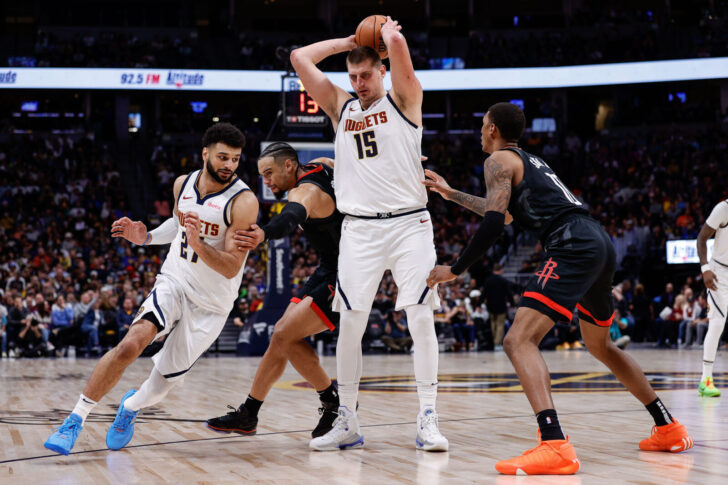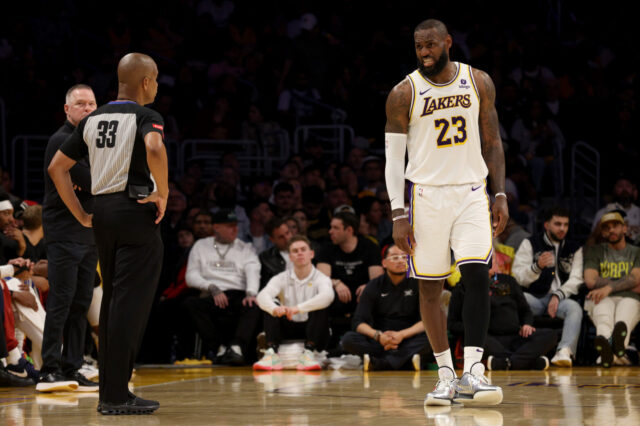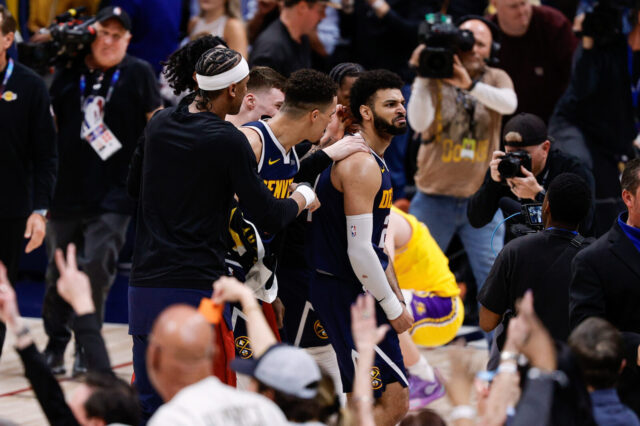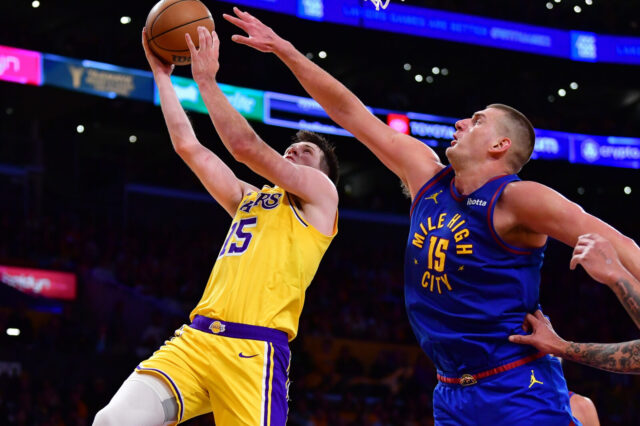It’s been a long time, but the break in Denver Nuggets action felt apt for a mailbag.
After beginning the season with a 14-7 record, the Nuggets are in the midst of a couple days off after a brutal start to the schedule. The In-Season Tournament is currently taking place, and the NBA, in wanting to feature those games, built in some off time for the rest of the NBA on Sunday, Monday, and Tuesday of this week. The next time the Nuggets have three days off in a row will be before February, so it’s important for the Nuggets to make use of this time.
With that in mind, let’s open up the mailbag and answer questions about what’s on Nuggets fans’ minds.
please help with understanding a nuance of the game. What is a “bad shot?” I dont see the difference between good/bad shot. (please dont say a bad shot is one that didn’t go in.) thanks.
— tabitha horner (@TABSTABS13) December 4, 2023
This is a great question, because there are so many factors into what makes a good or bad shot. I also like the addendum there, because bad shots go in all the time, and good shots miss all the time. It’s never as black and white of a conversation as “good shots vs bad shots.”
A “bad” shot is something that the offensive team is hoping to avoid, while the defensive team is hoping to force. There are a million factors that go into the how or why, but here are three easy steps to remember:
- Is the shot open?
- Is the shot valuable?
- How good is the player attempting the shot at that specific shot type?
A good shot is when those three parameters are met to a certain degree. A bad shot occurs when a shot is either contested, is attempted from a “not valuable” area, or is being attempted by a player that struggles in that zone.
Let me give two examples that should simplify it. In the first example, Nikola Jokic is dribbling the ball toward Kentavious Caldwell-Pope on the left side of the court and performs a dribble handoff. Caldwell-Pope receives the ball, dribbles once, and shoots a leaning two-pointer in the mid-range area.
In the second example, the Nuggets pass the ball to Aaron Gordon in the post, who takes one or two dribbles, then shoots a leaning two-pointer in the mid-range area.
These are similar shot types (pull-up two-point jumpers) taken in the mid-range area. Analytics says that one of them is a good shot, and the other is a bad shot. The shot KCP attempted is actually based on an action the Nuggets run within their offense, and Caldwell-Pope shoots 21-of-47 on two-point pull-up jumpers, according to NBA.com’s tracking data. That’s good for 0.89 points per shot, which isn’t the most efficient shot on the court but is still good enough to take in a halfcourt setting. It helps Caldwell-Pope stay involved within the flow of the offense and gives Denver’s other creators a possession to relax a bit. Gordon’s shot, on the other hand, is considered a shot the Nuggets should avoid unless they have few alternatives. Gordon has made just 2-of-14 pull-up two-pointers this year, which equates to 0.28 points per shot. It’s also a self-created shot, which is rarely a high efficiency play type for a role player at the highest levels.
Analytics have changed this discussion forever, but contrary to popular belief, they don’t say that the mid-range should be avoided at all costs. Analytics are just stats that tell a story, and the story with the mid-range often means that the best players should still take those shots. The more pressure those players apply in those areas, the more likely they are to generate those open, in-rhythm shots for role players, which are generally at the rim, behind the three-point line, or at the free throw line.
So, in conclusion, a shot generally good if it’s open, in rhythm, and attempted by a player capable of making it, while a bad shot is the opposite.
Something that always puzzles me is the amount of times players are jogging up the floor on a Jokic rebound. Knowing his proclivity for passing ahead, why not sprint and hunt easy baskets? MPJ and AG are rarely running hard. Maybe they would rather get in a half court set?
— Greg Scheckenbach (@GScheckenbach) December 4, 2023
The simple answer here is that it’s really difficult to always be running at all times. The Nuggets, coming off of a championship, are in a position where they’re trying to play the long game throughout the season. They know that running and pushing the pace is the best way to score, but balancing the need to win a regular season game with the need to win a playoff game four or five months from now can be pretty difficult.
The more complex answer is that always running isn’t always a great idea. Part of the allure of those hit-ahead passes is how often they take the defense by surprise. Teams know about Jokic’s touchdown passes though, and there have been multiple times when those passes have been picked off or deflected.
The best time to surprise a team in transition is when the floor is unbalanced by the opposing team trying to grab an offensive rebound or switch on defense. Those opportunities don’t always present themselves clearly, but Denver generally does a nice job of finding them in years past.
This year, the opposite has been true. In fact, the Nuggets are currently the least valuable transition team in the NBA, scoring just 1.074 points per transition play, according to Cleaning the Glass. That seems almost impossible with Nikola Jokic on the team, but it’s true. The Nuggets have fared poorly in transition this year. The only two players on the team above the 50th percentile in transition are Jamal Murray and Reggie Jackson. Others have struggled finishing at the rim, drawing fouls, or converting open threes generated in those moments.
Getting back Murray to help push the pace may help, but the Nuggets simply have to be better at capitalizing on those opportunities. Because right now, the Nuggets are a better halfcourt team than they are a transition team, factoring in offensive rebounds. It’s ludicrous.
Are the Timberwolves the Nuggets biggest threat to repeating?
— Soum Panda (@soum_panda) December 4, 2023
Right now, I think the Minnesota Timberwolves are the second best team in the West behind the Nuggets. The Timberwolves are a great, great defensive team, built around two pillars in Rudy Gobert and Jaden McDaniels. Gobert has lost a step defensively but is still incredibly impactful as a rim deterrent against almost every team, including the Nuggets. McDaniels has been hurt lately, but his defense against Murray early in the season stands out in a major way. At 6’11”, he’s the tallest defender Murray has ever faced as a permanent defensive matchup, and the technical passes and shots that Murray makes at the point guard spot are that much more difficult facing a taller player. The windows of opportunity are smaller, and while Murray is talented enough to break that defense, the fact that he has to is one thing that changes the matchup from last year.
Now, I think Denver still beats Minnesota in a playoff series, but they have my utmost respect. Anthony Edwards is for real, even if he’s not the most efficient superstar of all-time. Karl-Anthony Towns and Naz Reid (another absent factor from last season’s first round matchup) are each maintaining 50-40-90 seasons at the big man spots, which is insane. Mike Conley has been incredibly efficient, and the role playing versatility of Kyle Anderson, Nickeil Alexander-Walker, and Troy Brown Jr, is certainly intriguing.
Could other West contenders supplant the T’Wolves? Sure. The Phoenix Suns are dangerous offensively, but I’m not worried about their defensive matchups. The Los Angeles Lakers are a good team. They’re not a great team, at least not yet. The Oklahoma City Thunder are still probably a year away and another big man away from giving the Nuggets real problems. The Sacramento Kings and Dallas Mavericks aren’t good enough defensively.
I still maintain the two teams that give the Nuggets the most issues are the Boston Celtics and Milwaukee Bucks, though the Philadelphia 76ers are suddenly a bit more dangerous too.
Trade targets and if we even have enough assets to get anyone that would help!
— Trevor W (@Twell___) December 4, 2023
So, December 15th is the unofficial starting day of trade season, and the Nuggets will of course keep their eyes open for different options. My natural inclination is to say it’s too early really talk trades, but this is sports, and the internet, so I’m going to do the SEO thing and discuss “Denver Nuggets Trade Rumors News NBA Trade Deadline Ideas.”
I put this chart out a few days ago, a look at Denver’s Two-Man Lineup Net Ratings through the first 20 games of the season.
Green is good, and Red is bad. Following the red, the Nuggets have struggled the most so far with their bench lineups, especially those that have included Zeke Nnaji and Julian Strawther. Now, Strawther is a rookie, the 29th pick of the 2023 NBA Draft, and I didn’t expect him to be in the green very much this season. Nnaji, however, just signed a four-year extension this offseason, and the Nuggets haven’t been able to find a single combination that works with him on the court through the first 20 games. To be clear, playing without Jokic is a difficult task, but the Nuggets recently went to DeAndre Jordan at backup center and benched Nnaji. That’s not a great sign for a player they just signed for another four years beyond this one.
So, should the Nuggets look at backup center again? Maybe. They tried with Thomas Bryant at the trade deadline last year, but he wasn’t the right fit, and he was also just removed from the Miami Heat bench rotation. If the Nuggets were to acquire a center, they need someone who can screen, roll to the rim, rebound, and play an athletic brand of defense on the second unit. The centers good enough to help the Nuggets on that end are generally too pricy, but some names I’d check on are Jalen Smith of the Indiana Pacers (who they’ve had interest in before) as well as Day’Ron Sharpe of the Brooklyn Nets, Jericho Sims of the New York Knicks, and Omer Yurtseven of the Utah Jazz. Rim rollers that could provide a nice target for Murray and Jackson in the pick and roll.
The other position I think Denver could use is a versatile forward to replace Vlatko Čančar. The Nuggets, when putting together their offseason plan, didn’t account for the absence of Čančar, who suffered a season ending injury after free agency was all but over. Vlatko would have played this year, and without him, the Nuggets are missing a connecting piece off their bench that can guard multiple positions and do different things offensively.
Looking ahead to the trade deadline, players that fit that criteria and might be gettable are Jae’Sean Tate of the Houston Rockets, David Roddy and John Konchar of the Memphis Grizzlies, and Trendon Watford of the Brooklyn Nets. These are players who might make the necessary connecting plays off the bench, even if they don’t play all the time, and the Nuggets could use another player that can’t really be pushed around in their backup frontcourt. It might be one of the players listed above, or another player might make a surprise appearance.
Whatever the case, it’s important to take this slow. The Nuggets are 14-7 and just played the toughest portion of their schedule, and they’re about to get Jamal Murray back. They’re going to be fine, with or without a trade addition. These guys could simply provide a layer of help at the appropriate moment in the playoffs.




